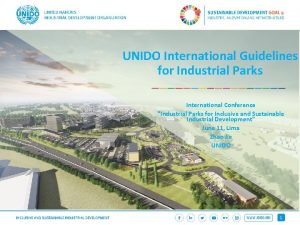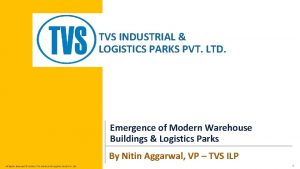International Approaches in Master Planning of Industrial Parks

- Slides: 1

International Approaches in Master Planning of Industrial Parks Economic and Environmental Efficiency of Industrial Parks India: VIZAG Steel Plant: Total Size: Under plant: 22, 000 acres max. 6, 000 acres Germany: BAYER Chemical Park Leverkusen: Total Size: 1, 000 acres, 6% undeveloped area workers: 30, 000 Existing since: 1891 Environmental Concerns in India: Germany uses a two tiers approach with several feedback loops: 1. The spatial Planning Procedure Improper Sitting 1. Adequate ‘designated sites’ in Master or Regional Plans do not exist or the designation is not based on environmental considerations. 2. As a result the development of industrial parks and of affiliated activities like housing, infrastructure and transport is often haphazard and un-coordinated and frequently causes serious disaster risks. 3. Insufficient consideration of environmental aspects often results in over exploitation of local resources, pollution problems, and negative impacts on the surrounding environment. 4. Consumption of land resources higher than necessary to achieve the socioeconomic results Site Master Planning Workflow Reasons for spatial Planning Ø Each Planning has a spatial component: All natural resources and environmental media are defined by their location. Ø Land natural Resources are limited: The demand for land exceeds the available amount of land. Ø The need for protection: Effective protection of natural resources and their sustainable use requires a proper management. Ø Conflicts have to be handled in a fair and productive manner: Demands are often conflicting. A clear and defined procedure is required to allocate land uses and to manage these demands in a fair manner. Environmental Problems within the Industrial Park 1. Layout of the industrial parks frequently does not meet the requirements of the industries; e. g. land for different functions (process, storage, transportation, infrastructures and services, disaster management etc. ) is not properly allocated and / or not adequately foreseen. 2. Infrastructures like roads, lightning, water supply, sewers, plantation, common effluent treatment plants, waste collection and management facilities are not adequate and / or not managed and maintained properly. 2. The design of the project itself 1. Assessment of property need – including development options 2. Topography of the site 3. Development of a theoretical basis for the site master plan Result Block Plan with Elevation Basic Objectives Ø Allocate land use to sites in accordance with their natural capabilities. Ø Preserve and protect sites of important and sensitive natural resources and environmental media by allowing only a type of land utilisation, which will not adversely affect the natural functions. Ø Plan and manage the rehabilitation of degraded sites in order to improve environmental quality. 4. Assigning functions to the block plan - Clustering of functions Result 3. Industries are not grouped properly and thus networking for efficient energy / material / waste flow is not possible. 4. Manufacturing processes and pollution control measures in industries are not up-to-date. Strategic approach Ø Determine Spatial Development Objectives: Develop spatial objectives in terms of protection conservation, rehabilitation and development in form of a spatial development plan - prior to any project. Environmental Problems outside the Industrial Park 1. Industrial parks do not fit into the natural settings. 2. Over exploitation of resources e. g. water. 3. Haphazard development of housing areas. 4. Impact on surrounding land uses viz. habitat, agriculture, forests, housing areas etc. 5. Stress on already inadequate supporting infrastructures viz. roads, hospitals etc. Ø Provide Complete Baseline Information: Compile and assess information on all types, qualities and sensitivities of the natural resources for the total area of a given planning region. Ø Offer Options for Development: This plan should provide sufficient land selected on ecological considerations for all kinds of future land uses from all sectors of the society such as: ¨ ¨ industrial development ¨ agricultural development residential development ¨ recreation development of the infrastructure ¨ Protection of natural resources resource extraction etc. 5. Detailing Result Principles of Plan Co-ordination ¢ Vertical and horizontal Co-operation: All new plans are developed in direct collaboration and interaction with all concerned authorities Principles of Plan Co-ordination: Counter Current Principle State Ministry of Regional Development and Environmental Affairs State Office for Environmental Protection 6. Development of standards for infrastructures: Tools for Plan Co-ordination State Office for Water Management Prescribed co-ordination procedures and required degree of mutual cooperation: District Government Water Resource Management of The District Environmental Protection Authority ¢ Informational notification: Plan contents of relevance for other plans is incorporated into those plans a) Streets ¢ by exchange of information b) Sewage system ¢ by mutual collaboration c) Drainage system for surface water ¢ by mutual consent d) Concept for fire-fighting water system ¢ informational notification: plan contents of relevance for other plans are incorporated into them Municipality Environmental Protection Department Local Nature Conservation Office e) Water management concept including reuse / recycling ¢ Prescribed time frames ¢ Integration of social, economic, ecological and cultural aspects; ¢ Involvement of bearers of public interest / stakeholders Decision Making and Execution 7. Safety concept Result Integrated Master Plan Site Leverkusen Decision-making as well as execution is the task of the lowest possible level within the administrative hierarchy State level Development Programme Setting for Decision Making and Plan Approval Regional Plan Immission Control Act Nature Federal Conservation Building Code Act Regional Water Planning Act Law Master Plan Legally Binding Layout Plan Existing Planning Objectives Legally Binding Plan Approval Directives Other stakehol ders NGO´s t Sectoral Administr ation or p p Affected Public ci e D on i s Interests Planning Laws Legal Basis De cis ion Su p Spatial Impact Assessment Procedure (SIA) po rt Su Private or Public Building Project EIA Supplementary Planning Examples: ¢ Licensing and control of industries: county (=taluka), municipality or even city level ¢ Approval of local master plans: county (taluka) level; for municipalities: district level ¢ Notification of water protection zones: taluka level, municipalities Consent Principle 68 ha 36 ha The vertical linkages between national, state and local level are not directing but guiding links 53 ha 32 ha Open Result Consequences: ¢ site and situation specific solutions ¢ democratic accepted solutions ¢ optimum solution under given circumstances INDO-GERMAN INSTITUTE OF ADVANCED TECHNOLOGY A nerve centre of Industry…. . We would like to thank CURRENTA (former BAYER Industry Services and BAYER Technology Services) who provided us with their experience and competence and their presentations.

